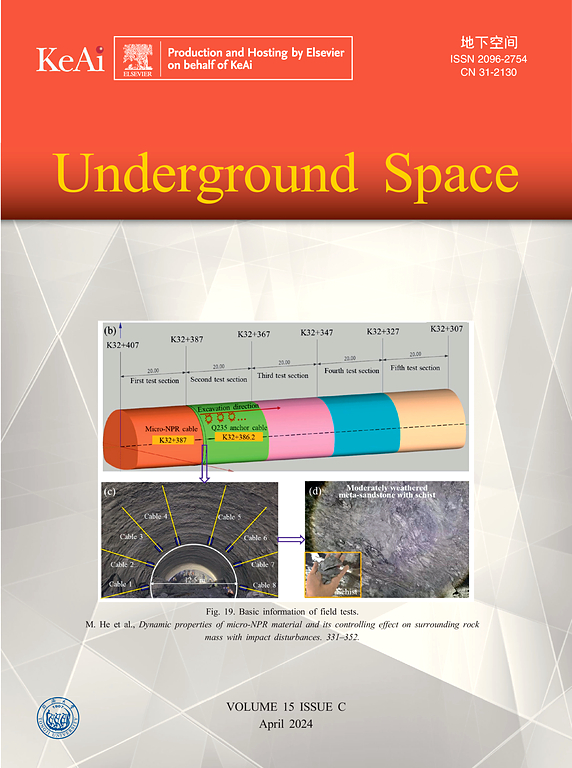考虑岩体质量和开挖扰动因素的围岩岩爆倾向性指数
IF 8.3
1区 工程技术
Q1 ENGINEERING, CIVIL
引用次数: 0
摘要
岩爆是由于深部围岩动力破坏而释放出弹性应变能的工程现象。现有的岩爆倾向性指标主要关注岩石材料,未能涵盖岩体质量和工程开挖扰动。以岩石破坏释放的潜在弹性应变能为基础,综合考虑岩体质量和开挖扰动因素,建立了5种围岩岩爆倾向性指标。首先,利用岩体弹性模量与残余弹性能(AEF)之间的线性关系、弹性模量与变形模量之间的关系以及与岩体质量评价指标(即岩体等级(RMR)、岩体基本质量指标(BQ)和地质强度指标(GSI)与变形模量之间的联系,推导出围岩岩爆倾向性评价模型。其次,利用RMR89指数、BQ指数和GSI指数对1级、2级、3级围岩的冲击地压倾向性进行评价,分析开挖扰动对围岩残余弹性能的影响;一般来说,岩体质量越高,扰动系数越小,围岩岩爆倾向性越大。通过27例岩爆现场资料,验证了所提岩爆倾向性指标的准确性。结果表明,基于GSI的岩爆指数判别等级与岩爆案例的实际发生等级基本一致,准确率达93%,可作为评价围岩岩爆倾向性程度的推荐方法。最后,讨论了岩爆倾向性评价模型存在的不足,并指出了改进方向。本文章由计算机程序翻译,如有差异,请以英文原文为准。
Rockburst proneness index of surrounding rock considering rock mass quality and excavation disturbance factor
Rockburst is an engineering phenomenon characterized by the release of elastic strain energy due to the dynamic failure of deep surrounding rock. The existing rockburst proneness indexes primarily focus on rock materials, failing to encompass rock mass quality and engineering excavation disturbance. On the basis of the potential elastic strain energy released by rock failure, five kinds of rockburst proneness indexes of surrounding rock are established considering the rock mass quality and excavation disturbance factor. Firstly, the linear relationship between elastic modulus and residual elastic energy of rock materials (AEF), the relationships between elastic and deformation moduli, as well as the link with rock mass quality evaluation indexes (i.e., rock mass rating (RMR), basic quality index of rock mass (BQ), and geological strength index (GSI)) and deformation modulus, were used to derive five assessment model of rockburst proneness for surrounding rock. Secondly, the rockburst proneness degree for three grades of surrounding rock (I: excellent rock, II: good rock, and III: fair rock) was assessed utilizing the RMR89, BQ, and GSI indices, and the influence of excavation disturbances on the residual elastic energy of surrounding rock () was analysed. In general, the higher the quality of rock mass and the lesser the disturbance factor, the greater the rockburst proneness degree of surrounding rock. The accuracy of proposed rockburst proneness indexes was validated by using the field data from 27 rockburst cases. The results demonstrate that the discriminant grade of rockburst index based on GSI is basically consistent with the actual occurrence grade of rockburst cases, with an accuracy of 93%, which can be used as a recommended method for evaluating the rockburst proneness degree of surrounding rock. Finally, the shortcomings of rockburst proneness assessment model are discussed, and the improvement direction is elucidated.
求助全文
通过发布文献求助,成功后即可免费获取论文全文。
去求助
来源期刊

Underground Space
ENGINEERING, CIVIL-
CiteScore
10.20
自引率
14.10%
发文量
71
审稿时长
63 days
期刊介绍:
Underground Space is an open access international journal without article processing charges (APC) committed to serving as a scientific forum for researchers and practitioners in the field of underground engineering. The journal welcomes manuscripts that deal with original theories, methods, technologies, and important applications throughout the life-cycle of underground projects, including planning, design, operation and maintenance, disaster prevention, and demolition. The journal is particularly interested in manuscripts related to the latest development of smart underground engineering from the perspectives of resilience, resources saving, environmental friendliness, humanity, and artificial intelligence. The manuscripts are expected to have significant innovation and potential impact in the field of underground engineering, and should have clear association with or application in underground projects.
 求助内容:
求助内容: 应助结果提醒方式:
应助结果提醒方式:


